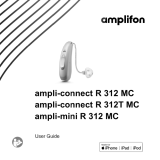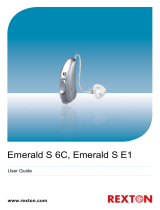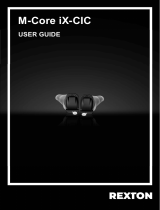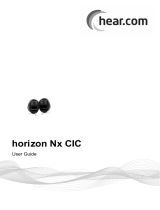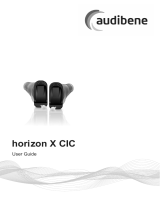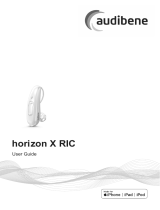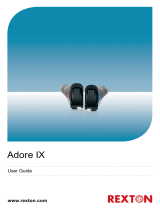Page is loading ...

Advance IF CIC x17,
Advance IF Canal x17
User Guide

2
Content
Welcome 4
Your hearing inruments 5
Inrument type 5
Getting to know your hearing inruments 5
Components and names 6
Controls 8
Settings 9
Batteries 10
Battery size and handling tips 10
Replacing batteries 11
Daily use 12
Turning on and o 12
Inserting and removing the hearing inruments 14
Adjuing the volume 17
Changing the hearing program 17
Special liening situations 18
On the phone 18
Maintenance and care 19
Hearing inruments 19
Ear pieces 20
Professional maintenance 22

4
Welcome
Thank you for choosing our hearing inruments to
accompany you through everyday life. Like anything new,
it may take you a little time to become familiar with them.
This guide, along with support from your Hearing Care
Professional, will help you underand the advantages
and greater quality of life your hearing inruments oer.
To receive the mo benet from your hearing
inruments, it is recommended that you wear them every
day, all day. This will help you get adjued to them.
CAUTION
It is important to read this user guide and the safety
manual thoroughly and completely. Follow the
safety information to avoid damage or injury.

5
Your hearing inruments
This user guide describes optional features that
your hearing inruments may or may not have.
Ask your Hearing Care Professional to indicate the
features that are valid for your hearing inruments.
Inrument type
Your hearing inruments are worn directly in the ear
canal. The inruments are not intended for children
under the age of 3 years or persons with a developmental
age of under 3 years.
Getting to know your hearing inruments
It is recommended to familiarize yourself with your new
hearing inruments. With the inruments in your hand
try using the controls and note their location on the
inrument. This will make it easier for you to feel and
press the controls while wearing the hearing inruments.
If you have problems pressing the controls of your
hearing inruments while wearing them, you can
ask your Hearing Care Professional whether a
remote control or a smartphone app to control your
inruments is available.

6
Components and names
This user guide describes several types of hearing
inruments. Use the following pictures to identify the type
of hearing inrument that you use.
IF Canal
➋
➎
➊ Ear piece (Click Sleeve)
➋ Battery compartment
(on/o switch)
➌ Push button
➍ Microphone
➎ Removal cord (optional)
IF CIC
➊ Ear piece (Click Sleeve)
➋ Microphone
➌ Battery compartment
(on/o switch)
➍ Removal cord

7
You can use the following andard ear pieces:
Standard ear pieces Size
Click Sleeve (vented or closed)
Click Dome™ single
(open or closed)
Click Dome semi-open
Click Dome double
You can easily exchange the andard ear pieces. Read
more in section "Maintenance and care".

8
Controls
With the controls you can, for example, switch hearing
programs. Your hearing inruments either have a
push button or no control.
Your Hearing Care Professional has programmed your
desired functions to the push button.
Control Left Right
Push button
No control
Push button function L R
Press briey:
Program change
Press long:
Standby/turn on
L = Left, R = Right

9
Settings
Hearing programs
1
2
3
4
5
6
Read more in section "Changing the hearing program".
Features
Power-on delay enables while-free insertion of
hearing inruments.
Read more in section "Turning on and o".
The Tinnitus Function generates a sound to
diract you from your tinnitus.
The wireless functionality enables simultaneous
control of both hearing inruments.
Read more in section "Wireless functionality".

10
Batteries
When the battery is low the sound becomes weaker
or you will hear an alert signal. The battery type will
determine how long you have to replace the battery.
Battery size and handling tips
Ask your Hearing Care Professional for recommended
batteries.
Battery size: 312 10
■ Always use the correct battery size for your hearing
inruments.
■ Remove the batteries if you intend not to use the
hearing inruments for several days.
■ Always carry spare batteries.
■ Remove empty batteries immediately and follow your
local recycling rules for battery disposal.

11
Replacing batteries
Removing the battery:
XOpen the battery
compartment.
XRemove the battery by
hand.
Inserting the battery:
XIf the battery has a protective lm, remove it
only when you are ready to use the battery.
XInsert the battery with the
"+" symbol facing upwards.
XCarefully close the battery compartment. If you feel
resiance, the battery is not inserted correctly.
Do not attempt to close the battery compartment by
force. It can be damaged.

12
Daily use
Turning on and o
You have the following options to turn your hearing
inruments on or o.
Via battery compartment:
XTurning on: Close the battery compartment.
The default volume and hearing program are set.
XTurning o: Open the battery compartment fully.
Via push button:
XTurning on or o: Press and hold the push button for
several seconds. Refer to section "Controls" for the
settings of your controls.
After turning on, the previously used volume and
hearing program remain set.
Via remote control:
XFollow the inructions in the remote control's user
guide.
After turning on, the previously used volume and
hearing program remain set.

13
When wearing the hearing inruments, an alert tone can
indicate when an inrument is being turned on or o.
When the power-on delay is activated, the hearing
inruments turn on after a delay of several seconds.
During this time you can insert the hearing inruments
into your ears without experiencing unpleasant feedback
whiling.
The "power-on delay" can be activated by your Hearing
Care Professional.

14
Inserting and removing the hearing inruments
CAUTION
Risk of injury!
XAlways wear the hearing inrument with an ear
piece.
XMake sure that the ear piece is completely
attached.
Inserting a hearing inrument:
XIdentify right and left hearing inrument so that you
insert it in the correct ear. The labeling on the hearing
inruments indicates the side:
"R" = right ear
"L" = left ear
XTake care that the ap of the Click Sleeve points
towards the printed text on the hearing inrument.
correct false
XHold the hearing inrument correctly before inserting
it: Pay special attention to the removal cord indicating

15
the bottom. If an arrow is printed on the hearing
inrument, it has to point upwards.
L R
XCarefully push the hearing
inrument into the
ear canal.
XTwi it slightly until it sits
well.
Open and close
your mouth to avoid
accumulation of air in the
ear canal.
■ It may be helpful to insert the right hearing
inrument with the right hand and the left
hearing inrument with the left hand.
■ If you have problems inserting the ear piece,
use the other hand to gently pull your earlobe
downwards. This opens the ear canal and eases
insertion of the ear piece.

16
Removing a hearing inrument:
NOTICE
Never pull on the battery compartment door to
remove the hearing inrument. This could damage
your hearing inrument.
XPush lightly on the back of your ear to loosen the
hearing inrument.
XRemove the hearing inrument by pulling the removal
cord towards the back of your head.
CAUTION
Risk of injury!
XIn very rare cases the ear piece could remain in
your ear when removing the hearing inrument.
If this happens, have the ear piece removed by
a medical professional.
Clean and dry your hearing inruments after usage.
Read more in section "Maintenance and care".

17
Adjuing the volume
Your hearing inruments automatically adju the volume
to the liening situation.
XIf you prefer manual volume adjument, use a remote
control. Follow the inructions in the remote control's
user guide.
An optional signal can indicate the volume change.
Changing the hearing program
Depending on the liening situation, your hearing
inruments automatically adju their sound.
Your hearing inruments may also have several hearing
programs which allow you to change the sound, if
needed. An optional signal tone can indicate the program
change.
XTo change the hearing program, press the push button
briey or use a remote control.
Refer to section "Controls" for the setting of your
controls. Refer to section "Settings" for a li of your
hearing programs.

18
Special liening situations
On the phone
When you are on the phone, turn
the receiver slightly so that it does
not completely cover your ear.
Telephone program
You may prefer a certain volume when using the phone.
Ask your Hearing Care Professional to congure a
telephone program.
XSwitch to the telephone program whenever you are on
the phone.
If a telephone program is congured for your hearing
inruments, it is lied in section "Settings".

19
Maintenance and care
To prevent damage it is important that you take care of
your hearing inruments and follow a few basic rules,
which will soon become a part of your daily routine.
Hearing inruments
Drying and orage
XDry your hearing inruments overnight.
XAsk your Hearing Care Professional for recommended
drying products.
XFor longer periods of non-use, ore your hearing
inruments with open battery compartment and
batteries removed in a drying syem to avoid the
adverse eects of moiure.
Cleaning
For hygiene reasons and to maintain functionality, clean
your hearing inruments daily.
XClean your hearing inruments daily with a soft, dry
tissue.
XNever use running water or immerse the
devices in water.
XNever apply pressure while cleaning.
XAsk your Hearing Care Professional for recommended
cleaning products, special care sets, or more
information on how to keep your hearing inruments
in good condition.

20
Ear pieces
Cleaning
Cerumen (ear wax) may accumulate on the ear pieces.
This may aect sound quality. Clean the ear pieces daily.
XClean the ear piece
right after removal with
a soft and dry tissue.
This prevents that
cerumen becomes
dry and hard.
XSqueeze the tip of the ear piece.
Exchanging
Exchange andard ear pieces approximately every
three months. Replace them sooner if you notice
cracks or other changes. The procedure for exchanging
andard ear pieces depends on the type of ear piece.
In section "Components and names", your Hearing Care
Professional has marked your type of ear piece.
/

